Do you want to break through the noise? To climb over the clutter and emerge as the beautiful thought leader that you know you are? In today’s digitally-dominated world, market segmentation is your key to rising from the safe bounds of your chrysalis into an inspiring world of success. ‘How?’ I hear you ask. Before we get into the ‘hows’ and ‘whys’ of market segmentation, let’s take it back to the ‘what’...
It’s important to remember that these individuals allow your brand to thrive. So, reaching the right people, in the right place, at the right time is key. And it’s market segmentation that makes all of this possible for you.
Camilleri notes that:
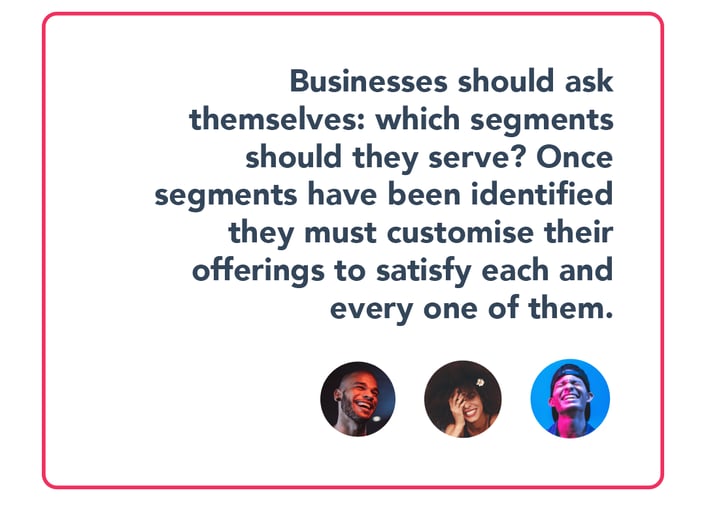
Market segmentation is the first move any brand should make when determining the desired target market. Why? Because the very nature and function of market segmentation is to allow you to create those legitimate, relevant and ultra-precise audience segments that are the perfect match for your brand.
Segmentation essentially gives your brand confidence in the knowledge that the people you are reaching are the most appropriate audience for you, and will find your product, service or content meaningful and valuable. Research shows that 34% of consumers would be motivated to promote a brand online if the content that’s shared is relevant to their interests.
Related content: [Infographic] Market Segmentation Matters
You might be thinking, accurate market segmentation seems tough. Which it can be. However, with the help of a well-structured marketing strategy, the right tools, big data and the array of actionable insights that this data provides, anything is possible. We’ll touch on the topic of big data later on.
But before we get into all that, let’s take it back a step and have a brief peek into the history of market segmentation.
Segmentation, in its purest and most basic form, has been around since the 1950’s - 1956 to be exact. The term ‘Market Segmentation’ was first coined by marketer and academic, Wendell R. Smith.
It started off small, by segmenting users based on simple demographic information. Of course, this is still used today, but segmentation in the 21st century has grown to be much more varied and complex.
It’s no surprise that we’ve come a long way since 1956. And modern market segmentation is so multifaceted that it gives you the opportunity, and options, to be super-specialised. Segmentation facilitates the delivery of content that is streamlined, personalised and gives value to your users. It’s so advantageous as a marketing tool that any brand would be foolish to overlook it.
Source: Campaign Monitor

To be entirely truthful, personalisation today is so common that people actually expect to receive messages and products that are highly tailored. If you think about it, It would be totally normal and plausible for someone to think…
Giving users what they want, i.e. hyper-personalisation and relevant offerings is essentially a requirement for brands today. And this is only achievable through clever segmentation.
Sarah Mansfield, VP of Global Media for Europe and the Americas at Unilever, puts it this way:
“[Personalised marketing is] a journey from mass reach to mass customisation to mass personalisation. It’s about reaching large audiences but doing it in a really smart way [and this requires] understanding consumers, their traits and behaviours, to identify actionable targeting segments for which we can develop different messages. In summary, true mass personalisation means the right time, right place, right targeting.”
Accurate market segmentation can be beneficial for both brands and individuals. Accuracy, here, begins with properly obtaining and using data i.e.:
Only once you have established your brand’s goals, and have gathered and analysed your data appropriately, can you then fully utilise your segmentation outcomes.
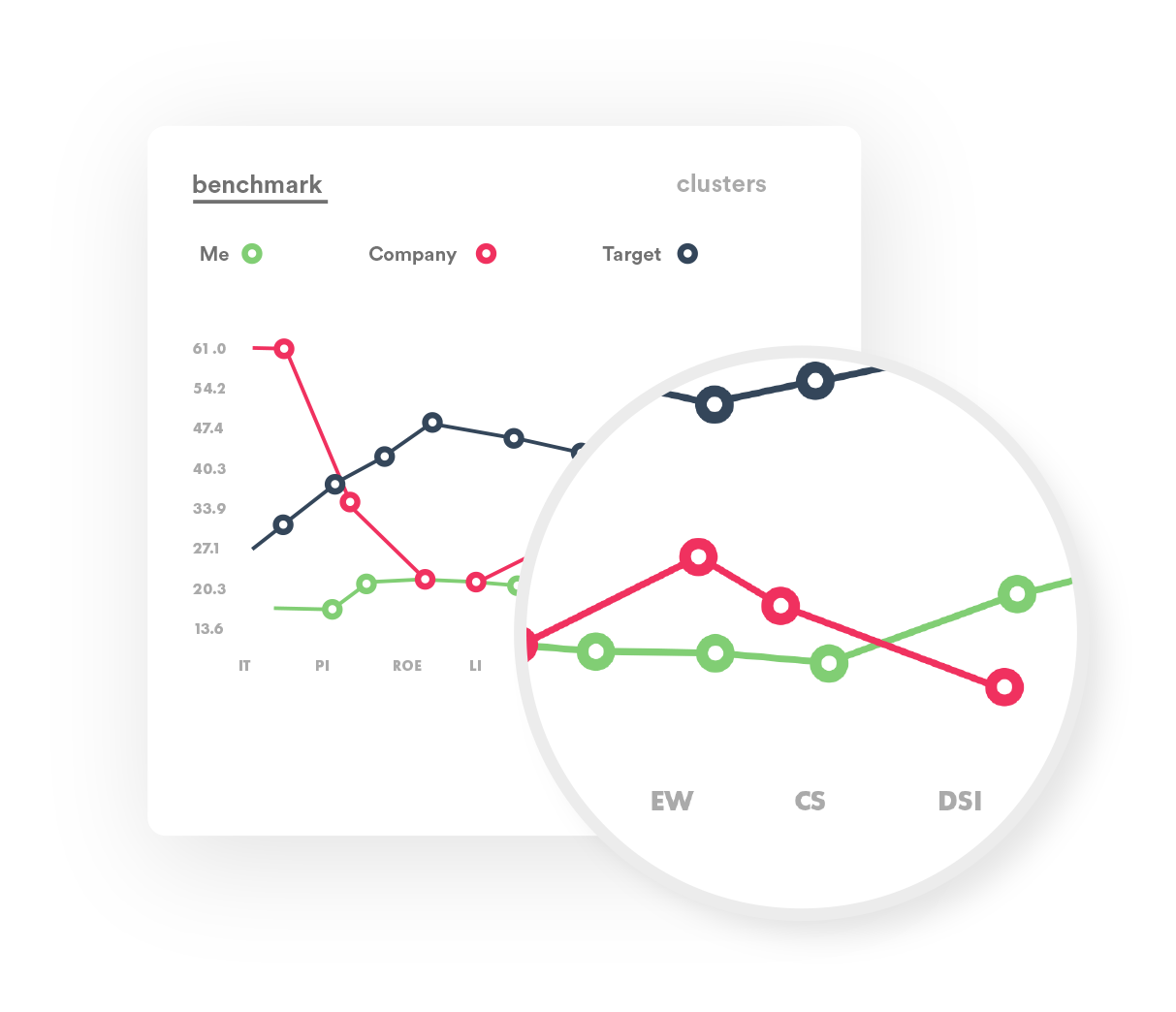
The benefits are real. Precise segmentation simplifies and facilitates the process of setting objectives, strategising and tailoring products, services and brand-audience contact. And the benefit for these segments and the individuals within them? Well, they then receive connections and offerings from brands that are highly personalised and intelligently delivered, i.e. to the right person, in the right place, at the right time.
Related reading: The Age of Intelligent Automation
First of all, what is big data? Put simply, big data describes a large, and continuously growing, volume of online information - both structured and unstructured. This information is collected, recorded, stored and analysed with the purpose of uncovering actionable insights that add further value to your brand.
Or as Gartner puts it:
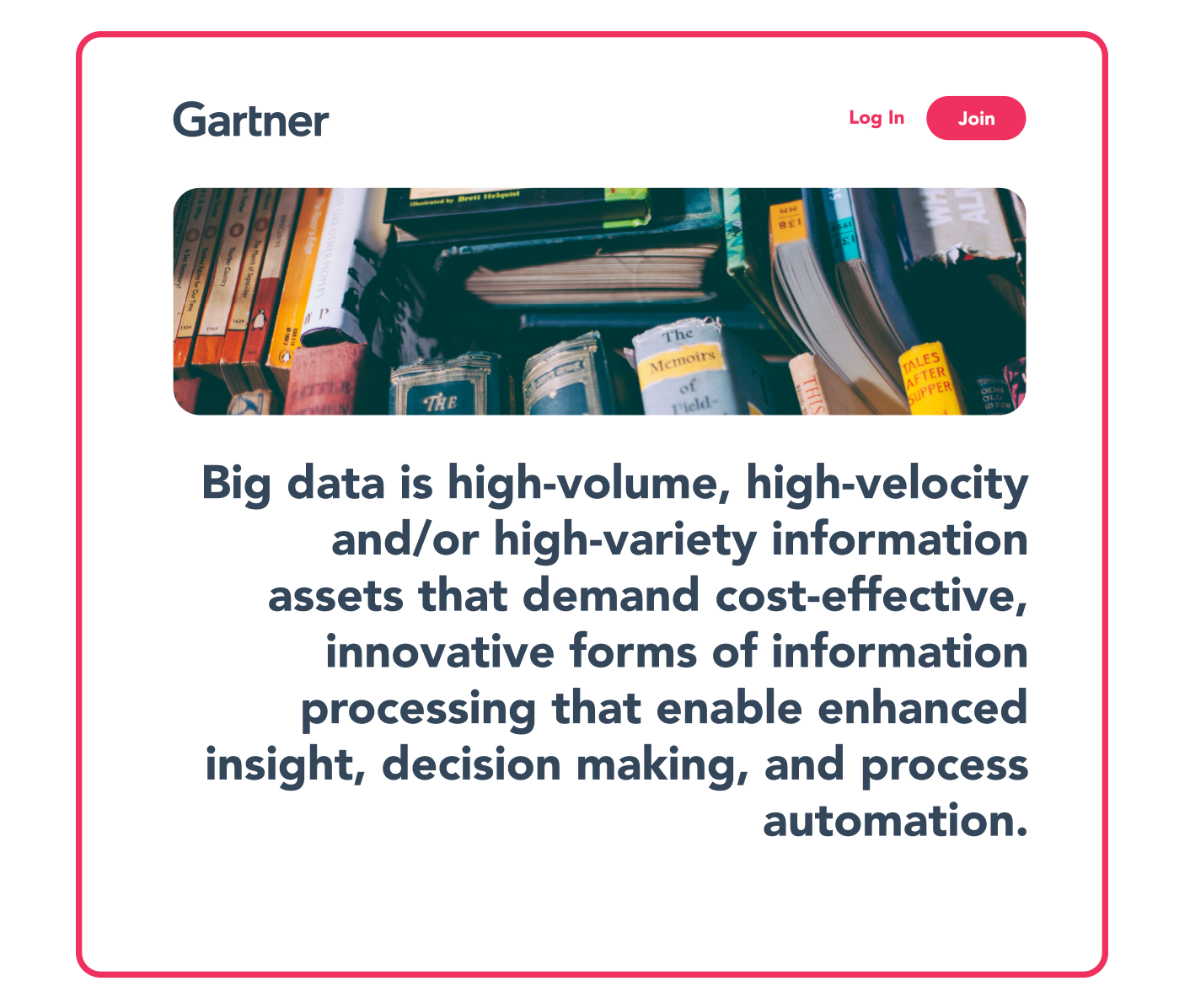
It has been proven that data driven marketing can work. So it’s no surprise that more than 63% of marketers claim to have increased their spending in this area. In fact, around 20% of all marketing spend today goes on data-driven campaigns.
Gauging the intentions and meeting the needs of current and prospective audiences is an ever-present quest for brands today. And, when it comes down to it, brands can only segment a market based on what they know.
In the not-so-distant past, it was relatively difficult to gather data that went further than, say, basic information like someone’s age, gender or income. This inability to gather consumer data meant that marketing was once almost entirely one-sided; with marketers simply guessing the needs and wants of individuals and groups with little information to back-up their marketing efforts.
But not today. Times have changed. Big data itself is advancing at an alarming rate, as are the endeavours of brands.
Don’t get me wrong, big data isn’t some kind of magic genie that will grant all of your wishes, but what it can help with is…
Related reading: [Infographic] Hit The Bullseye with 4 Top Market Targeting Strategies
The rate at which brands are able to collect and analyse digital data is remarkable, given the fact that data is constantly accumulating. In fact, according to computer software company Domo, around 2.5 quintillion bytes of data are created each and every day… globally. It’s clear that this number is only going to increase as the number of internet users worldwide has grown by over 2 million in the past 10 years. That’s really something.
So, it’s no wonder that brands utilise data from multiple sources, simply because the data is so widely available and, arguably, because it’s now a necessity. That is, if you want to keep ahead of competitors and draw deeper, more intimate relationships with your audiences by offering the level of personalisation that they have come to expect.
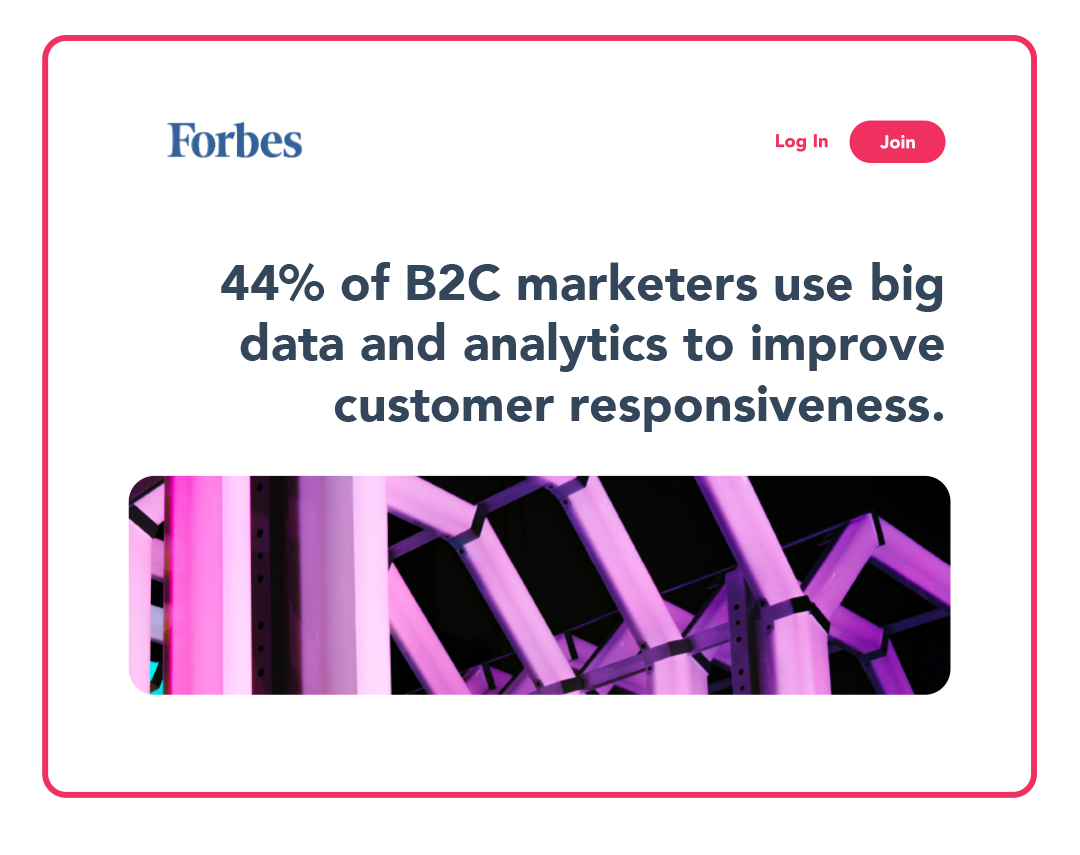
Source: Forbes
Big data puts the individual at the centre of your marketing strategy. It leads the way and clarifies your segmentation process in order to draw the best results for both the brand and the audience. Those businesses that mass-market or target a large, indiscriminate number of segments run the risk of diluting their brand. This is why big data is fundamental in modern-day marketing.
As well as identifying both the similarities and nuances of individuals, big data tracks consumer segments as they evolve. Meaning that as audiences change and grow, so does their data. So a user who is currently a young, spritely law graduate could later become a high-end, seasoned barrister, with different requirements and interests.
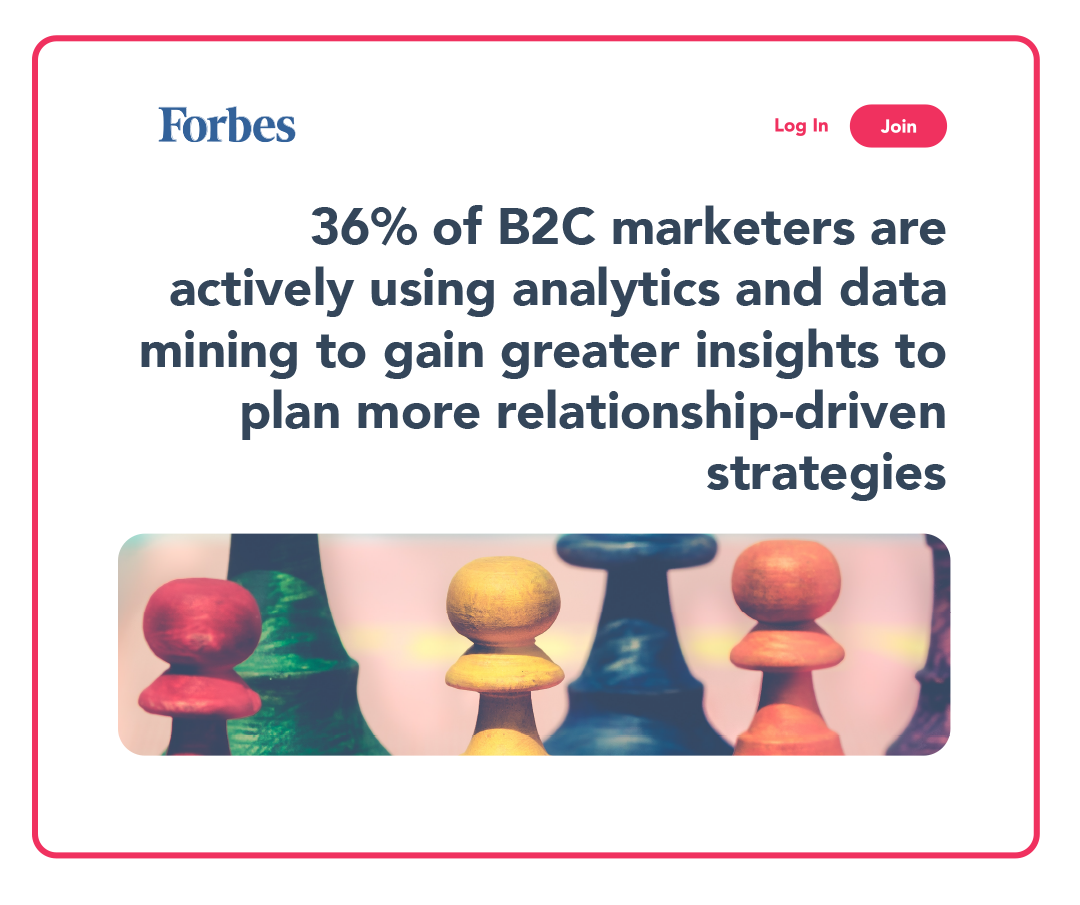
Source: Forbes
Essentially, people change and big data changes with them. This then paves the way for brands to be consistent in their marketing efforts by adapting their personalisation endeavours and, consequently, boosting brand loyalty by optimising user experiences.
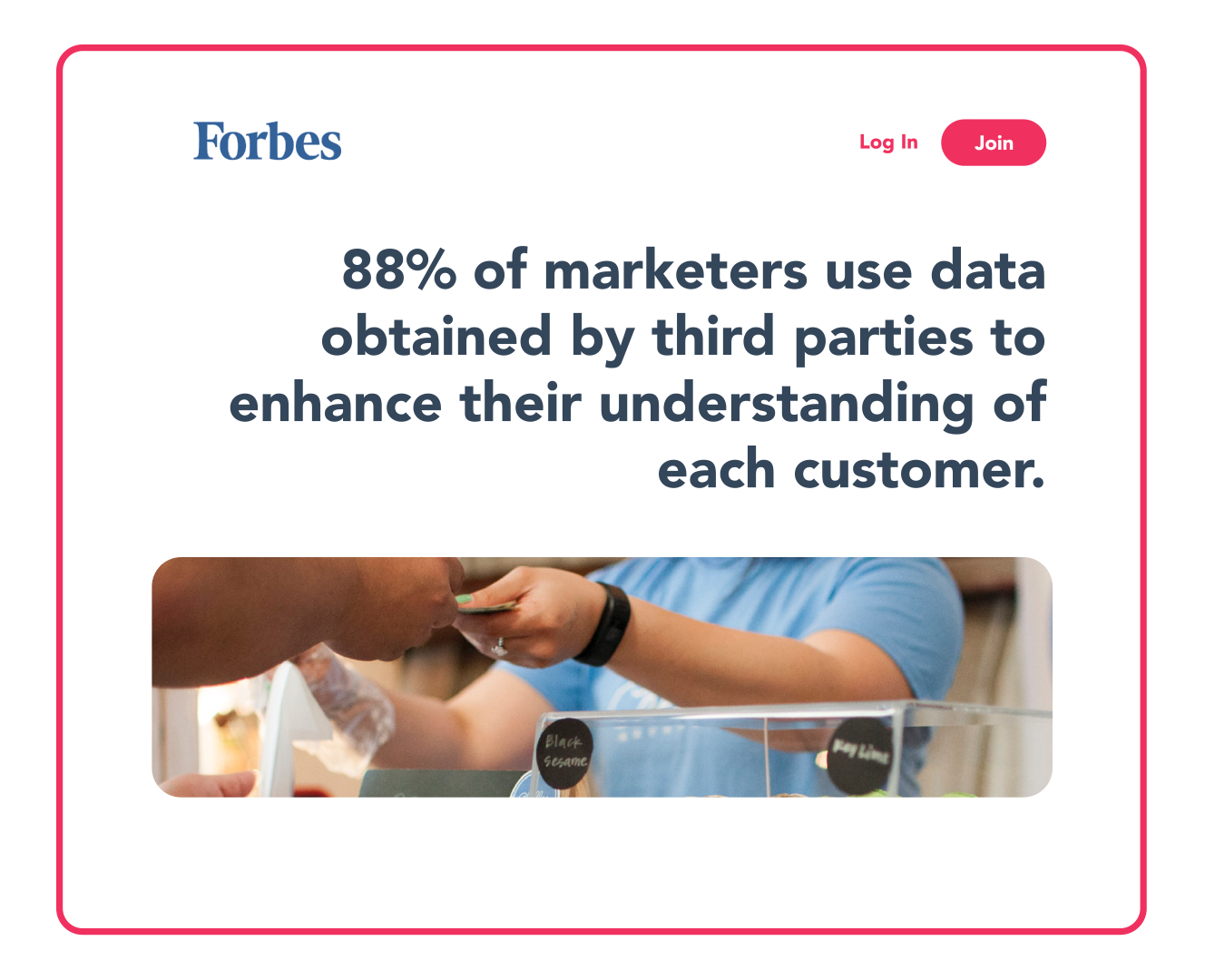
Source: Forbes
Getting to grips with the similarities and differences of your current and prospective audiences is what makes accurate segmentation possible. Segmentation today is data-focussed and data-driven.
It’s the intelligent use of big data that gives brands the ability to properly engage with consumers, have an edge over their competitors and ultimately become market leaders, thought leaders and outstanding digital disruptors. Between big data and the normalisation of personalised communication, market segmentation is basically a must for any brand looking to make it in the big wide world.
So, where do you begin?
We’ll start from the top with the main types of segmentation.
Segmentation is a marketer’s best friend and can certainly be the key to skyrocketing your brand’s success… but that’s only if you select the right type of segmentation for your brand.
We now know that segmentation is the subdivision of a market. But what matters most is deciding which type, or types, are right for your goal. For example, there’s no point in delving into something like demographic segmentation if the age or income of your audience is irrelevant. In the same way, there’s no use in identifying your user’s behaviour if it’s their geographic location that identifies them as valuable.
There are 4 main types of market segmentation:
Each type will serve its own unique purpose, and all of them vary in their functions, elements and what they can offer your brand. Chances are that your marketing strategy will include at least one of these different market segmentation types, so let’s take a closer look at each.
Demographic segmentation organises a market based on their most basic elements: their demographic information. It is one of the simplest and most commonly used forms of segmentation. This can be put down to the fact that demographic data is one of the easiest for brands to collect and analyse in a short amount of time.
So what does demographic segmentation take into account? It focuses on a range of information, but predominantly revolves around these elements
However, there are many more aspects which are further discussed and debated right here: The Pros and Cons of Demographic Segmentation
It’s fair to say that ‘age’ is an important differentiator with market segmentation. And that’s because peoples’ tastes, experiences, needs and wants tend to change over time. For example, a middle-school student might want a phone that’s well optimised for social media usage and photo storage, whereas an older professional might be more focused on the integration and UI of business-specific features.
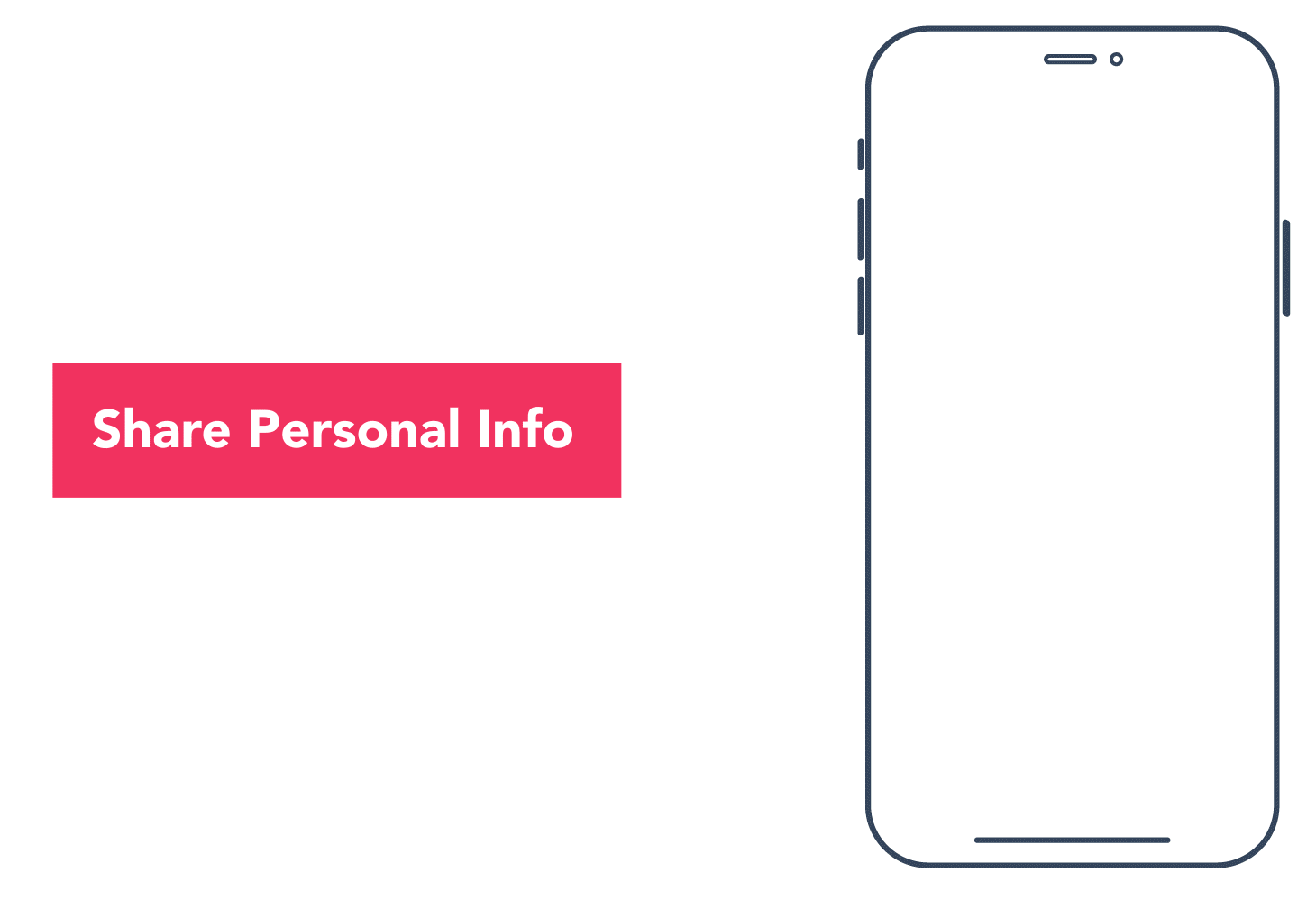
Source: Salesforce
Whilst demographic segmentation undoubtedly has its fair place in a number of different industries, for some, the basic information it draws is too shallow.
Take the entertainment giant Netflix, for example. Netflix wouldn’t get very far simply by segmenting its users based on their income. And that’s because Netflix has a well laid-out, 3-point subscription plan, with the only major differences being the number of screens you can watch on and whether you watch in HD or Ultra HD. Demographic data simply isn’t enough for entertainment brands like Netflix. Demographic information doesn’t dictate your audiences’ entertainment preferences, so that’s why they look to deeper segmentation sources.
So, the big question is, is demographic segmentation enough for your brand?
You might be similar to other brands in the sense that, yes, demographic segmentation has its firm place in your marketing strategy. Or you might think, well, it’s not enough but it definitely makes a difference when paired with elements of geographic segmentation! At the end of the day, if you know your brand well enough, you will know which segmentation types are the most appropriate for you, i.e. which will elicit the greatest return for both your business and your customers.
Related content: Hack HENRY: Maximise Millennial Marketing With Demographic Segmentation
Let’s move on and see what other segmentation types have in store for us.
Geographic segmentation groups audiences based on, you guessed it, their geographic information. But there’s more to this than you might think. That’s right, geographic segmentation doesn’t just look at an audience’s current residence or the street that they live on. It actually constructs different target groups based on a number of integral aspects, most importantly these 5:
Why do all of these differences matter?
Put simply, they all matter because they all have the ability to impact your segmentation efforts in a multitude of ways.
You see, you may find a number of individuals living in the same country and think that you can segment them based on this simple, common factor. But, in reality, it would make sense to create smaller, separate segments as this particular country may encompass two different languages, for example.
You might be thinking, this all seems quite obvious. However, if you simply group audiences by singular, broad factors, without accurate segmentation analysis, you may find that whilst factors such as their zip-codes are the same, their cultural values or climate may be opposing.
In this case, it wouldn’t make sense for a shoe store to offer sandals to those living in a snow-peaked mountain range. Similarly, it would be inappropriate to offer a waterproof winter coat to residents of a hot, dry climate.
The same goes for cultures, attitudes, and lifestyles. It’s clear to see that every audience will have specific needs, wants and requirements, and must be segmented accordingly.
Take a look at this blog for a deeper insight into geographic segmentation:
It’s important to note that, at first glance, geographic segmentation appears to be globally-focused. But don’t be fooled; geographic segmentation is as much of an effective approach for small, local businesses and small-medium enterprises (SMEs), as it is for global and international markets.
Much like demographics, geographic data is relatively easy to collect, analyse and implement in your marketing strategy.
But it’s not always simple demographic or geographic information that brands require. Often it’s a deeper, more personal look into an audience that really makes the difference.
That’s where psychographic segmentation comes in.
When you dive deep into your target market and discover who your audience really are, you know you’re taking the right steps on the path to success.
Why? Because the more you get to know your audience the better you can accommodate them; cater to their needs and discover their motivations. In today’s digital landscape, you can easily find out who your audience is, but going one step further and discovering the fundamental aspects of their characters is even more valuable.
Cue: psychographic segmentation.
Psychographic segmentation branches from aspects of psychology, which centralises on things like personality traits, perceived values, interests, lifestyles, and motivations. So, as you can imagine, identifying these aspects of your audience will undoubtedly be advantageous to your marketing strategy.

Incorporating psychographic segmentation in your marketing strategy can optimise your personalisation efforts and draw actionable insights.
Here's how:
You might be wondering how psychographic segmentation really differs from the basic geographic or demographic elements. Well, if you think about it in layers, simple segmentation methods are just the surface; significant, but depthless. Psychographic segmentation, however, is deeper. It spans from the top layer, throughout the middle sections and right down to the fundamental foundations.
The versatility and potential value of psychographic data are what make it so powerful. It helps you to get to know your audience by their emotional and personal details, enabling you to understand exactly what it is that motivates them and gauge how they may respond to your brand.
This all sounds amazing, right? But it’s not all roses. You see, whilst psychographic data has the potential to bring added value to your brand, the data itself can be quite difficult, and time-consuming, to gather.
Additionally, as the data can be biased, subjective or misinterpreted, it’s imperative that the information you collect is entirely relevant, accurate and will be applied in the most appropriate way i.e. *cough* compliant with GDPR regulations.
It can also be more difficult to categorise this data, given the fact that it’s based on psychology and therefore tends to be personal to each individual. Of course, this is a huge benefit for those brands working with a niche market.
One of the most common forms of segmentation in today’s digital age is behavioural, and it’s clear to see why. Let's take a look...
What is behavioural segmentation and why all the fuss?
Behavioural segmentation entails dividing and grouping an audience [or audiences] based on how they act. This could range from in-app and website behaviour to actions made in-store. And the fuss is there because behavioural data has the potential to bring huge amounts of value to brands.
Take app-use, for example. There are currently over 2.7 billion smartphone users globally, and 90% of mobile time is spent on apps. And with over 2.8 million apps currently available for download on the Google Play Store, in-app behaviour is entirely significant for brands when it comes to shaping who they are, what they offer and how they offer it.
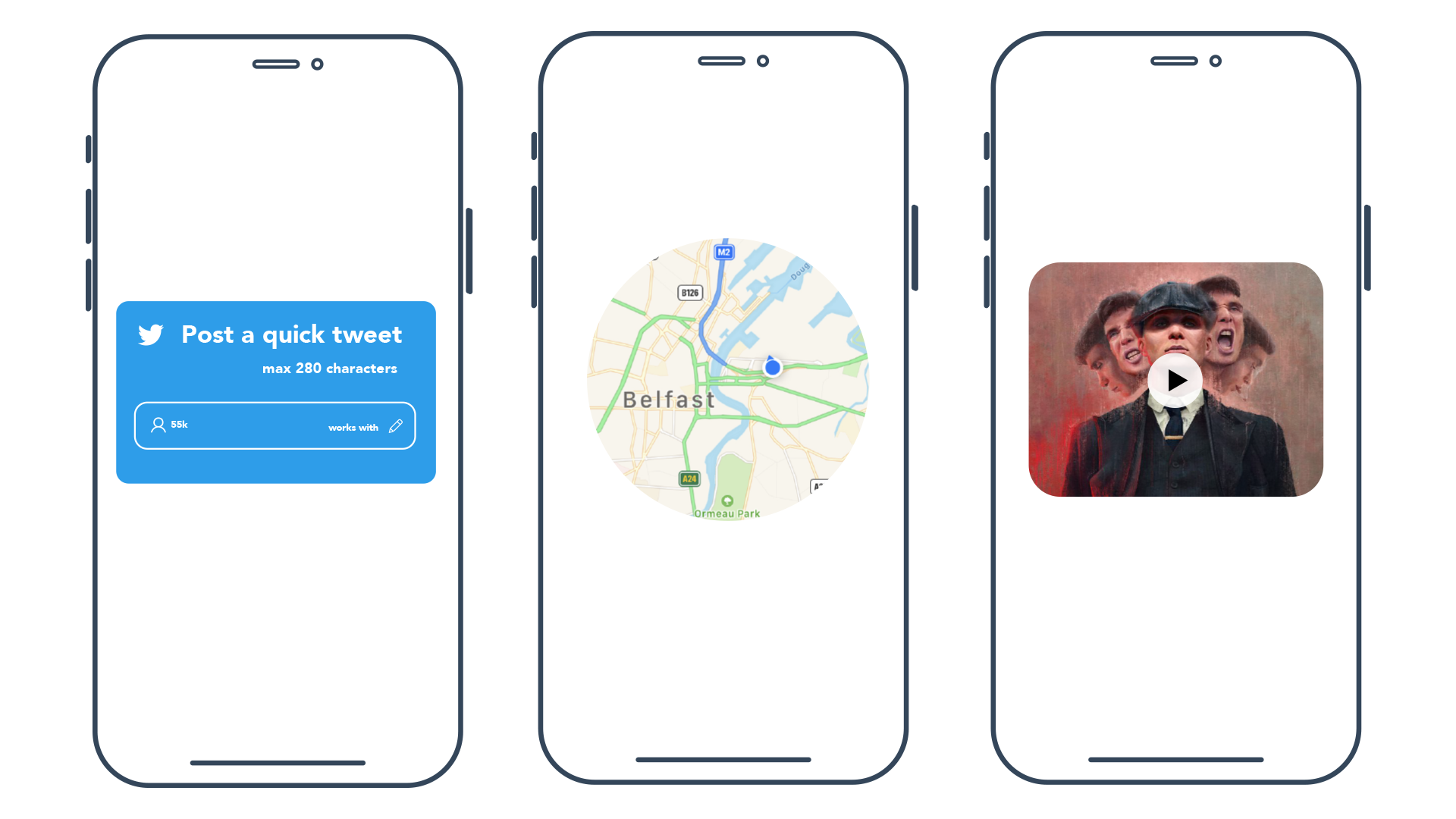
Behavioural data provides brands with a clear window of opportunity. By this, I mean that those organisations leveraging behavioural data can see benefits such as an increase in ROI and improved customer experiences.
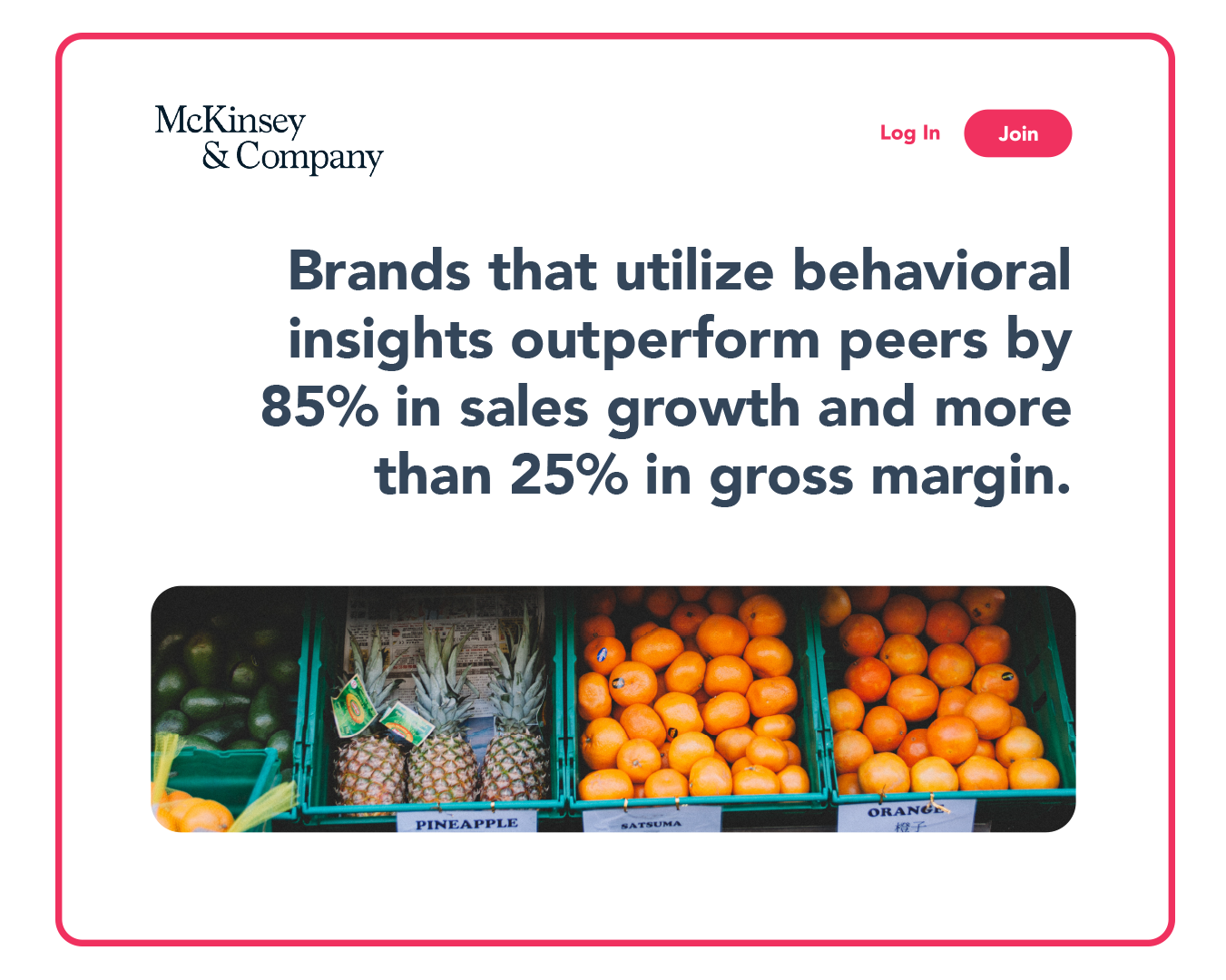
Source: McKinsey
Opportunity is a key concept here. It’s important for brands to realise that the actions of their audience are impactful and present an opportunity for improved user experience. After all, user experience is one of the fundamental features of marketing success.
To put the significance of behavioural data into perspective, we’ll go back to the example of app-use. Imagine you’ve created a brand new app, the UI is great, the design is perfect, you’ve just launched it and you’re ready for your eager audience to get on board. And they do! Happy days.
The only issue is that there’s an area of your app in which users make no actions, and people are connecting with your support team to try and understand how the area works because you haven’t made the purpose or navigation clear enough.
The function of behavioural data analysis is clear: take note of your users’ actions and alter or evolve your app accordingly. In the case of this example, it would be smart for the brand to re-design the area of confusion so that users can enjoy it without any trouble, or erase the area completely if it isn’t functional.
The beauty of gathering and analysing behavioural data is that it also allows for more precise and valuable A/B testing. And this benefits everyone, simply because the findings and decisions made as a result are based on real data rather than presumed knowledge.
Essentially, behavioural data gives brands the advantage of knowing when, why and how to optimise their audiences’ experiences which, in turn, facilitates streamlined brand development.
The essential goal of behavioural segmentation is to understand what your audience is doing and subsequently use your analysis to make their experiences more personalised. It’s important to note that behavioural data is often best used when combined with other segmentation strategies. For example, knowing how someone acts within your app is great, but you will gain even more meaningful insights when you pair this data with further information, like their interests, location or age.
So what about when you’re not targeting individual audiences and public segments. What about when you work B2B and your primary focus is on organisations? Here’s where firmographic segmentation takes centre stage.
To discover a little more about the opportunities and intricacies of behavioural segmentation, along with 3 handy case studies, take a look at this blog:
Firmographic segmentation entails grouping and separating firms based on their descriptive attributes, and can describe businesses, nonprofits and government entities. Essentially, B2B companies use firmographics for businesses and organisations in the same way that B2C companies use demographics for people.
What does firmographic segmentation take into account?
Much like other segmentation types, the aim of firmographic segmentation is to gain a deeper understanding of your target market; to give you insights into new business opportunities, such as gaps in the market and burgeoning trends. With the wide variety of data available today, the optimisation of your marketing strategy becomes much smoother.
The 4 primary market segmentation types are integral to any marketing strategy, and for any brands looking to see continued success.
If you’re struggling to delve into the formalities of segmentation, or perhaps you want a little more pre-segmentation guidance, look into the M.A.S.D.A. model to begin the process of efficiently clarifying and deciphering your strategy.
It goes without saying that for your segmentation strategy to be on-point, there are a few boxes that you have to tick.
You need to evaluate your market segmentation criteria to ensure that your audience is the right audience for you and that your offerings are relevant and appropriate for them. The M.A.S.D.A. model can help you achieve this.
So, what is it? The M.A.S.D.A. model is a set of criteria primarily used for guidance and structure. It is especially useful when planning your market segmentation strategy.
The acronym stands for: Measurable, Accessible, Substantial, Differentiable and Actionable.
Measurable
Value. Size. Purchasing power. Profiles. Any reliable, and therefore worthwhile, market segment should be quantifiable. That way, marketing strategists can easily decide whether, and to what extent, they should focus their efforts and resources on this segment. After all, if you can’t measure your rate of growth then how are you to know whether your chosen segment is truly valuable?
Accessible
Reaching, connecting and serving. There’s no use selecting a market segment that’s out of reach, whether that means geographically, physically, psychologically or otherwise. Your brand has to be sure that your offerings are valuable and accessible in order to see any kind of success.
Substantial
This third element requires brands to consider a segment’s potential; is this audience large enough to be profitable, both now and in the future? The last thing you want to do is waste your marketing budget on a segment with little worth. Longevity is also an important aspect to factor in: there’s no use in exhausting your brand’s time, money and effort on an audience segment which is likely to disappear within a short space of time.
Differentiable
Homogeneity. Your brand needs to aim for a homogeneous segment, i.e. the chosen audience has similar preferences and characteristics, to avoid overlapping into different or irrelevant segments. It would be pointless to market to a small set of individuals if your product appeals to a wide range of audiences, and vice-versa. Accurate differentiation of segments means that your marketing team can avoid any unproductive disturbances and can segment with clarity and structure.
Actionable
So, what does all of this matter if your market segmentation efforts don’t actually have a practical value? Basically, it doesn’t matter at all. Actionability is the crux of this entire 5-point criteria, and of your overall strategy. Without actionable insights, your brand is unable to reach and affect your desired audience thus wasting your precious time, resources and energy.
In today’s global economy, understanding and focusing on the fundamentals of market segmentation should be at the core of any brands strategy when looking to bring added value to a market. And the key to flawless market segmentation? The effective allocation of resources and the knowledge that your target segment will bring value, notoriety and brand equity right back your way.
Ever since it was first coined in 1956, the prominence of market segmentation and its problem-solving capacity has been clear. This is because all brands, whether global or local, need to identify different audiences in order to discover what really works and where, why and how value can be delivered.
In an age where increased sensitivity and differentiation of audiences is the key to a sustainable competitive advantage, segmentation by preference and other functional structures becomes an approach that marketers would be foolish to overlook.
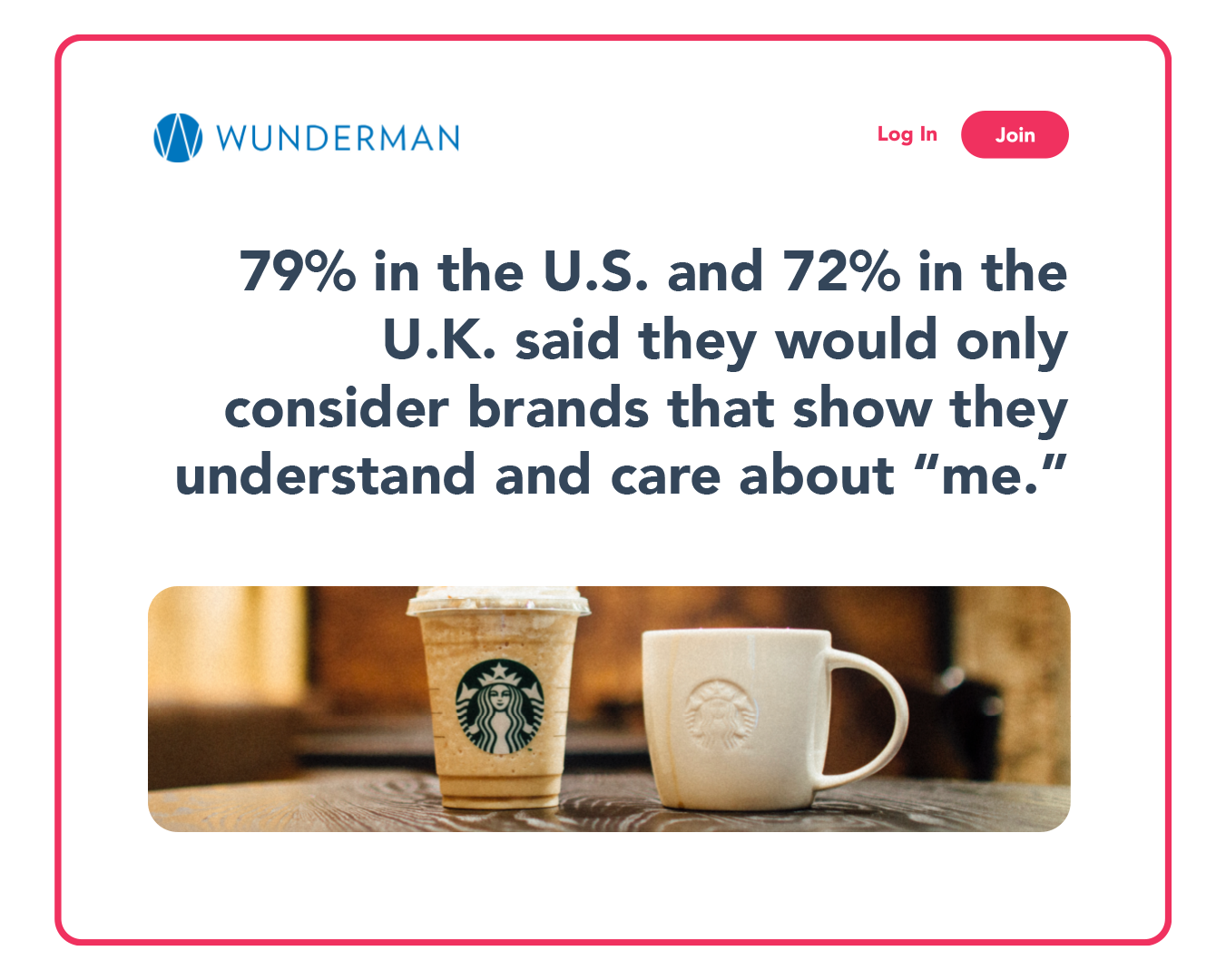
Source: Wunderman
So what are the real benefits of market segmentation? Well, we’ve got a few ideas:
Market segmentation gives you a deeper and clearer understanding of what you need to focus on and what you should avoid, and why.
For example, there’s no point in offering the biggest, most chocolate-y cake to your audience if the segment that you’re targeting consists of individuals who are lactose-intolerant or opt for a vegan or dairy-free diet. This would not be favourable for your brand.
Market segmentation alleviates potential blunders like these by meticulously analysing data which lets you know the preferences of your audience. This means that you can focus all of your efforts on aspects of your product, service or content that you know will be well received by this audience. I mean, you might even be rewarded with the sought-after position of Thought Leader in your industry, if they really love your stuff!Market segmentation is essentially an exaggerated form of hyper-organisation and analysis: once you have grouped your audience and analysed their data, you can then move on to looking at things like your budget and how you can effectively utilise it to offer your segment the most value. Clever segmentation is also used as an advice tool; by establishing the most appropriate areas to allocate your precious resources in order to get ahead of those problematic competitors.
When it comes down to it, a brand without focus is essentially lost. So in order to find yourself, so to speak, and flourish in your industry, you need market segmentation.
Related content: The Importance of Behavioural Segmentation in the Online Betting Industry
Market segmentation grants you business focus by offering:
Naturally, once your business focus increases, your drive to create the perfect product will follow suit.
Research shows that 30-45% of new products fail to deliver valuable financial return.
Wow. We really don’t like the sound of that. But I’m afraid that’s the harsh truth. So unless you’re really into mass marketing, chances are you can’t just make any-old product and ship it off to market. Because the nature of segmentation means recognising and understanding the different requirements of your audiences; specifically honing in on these requirements and developing products that are likely to be highly sought-after by a particular group.
Related content: [Video Interview] Creating a Marketing Strategy for a Global Product
That’s the beauty of market segmentation. Your product development will begin simply as an idea and will swiftly be concentrated into a specialised, segment-specific product with unique features and functions.

Without market segmentation, where do you begin? It’s tough to know which product to offer your audience, and which features and functions will be entirely necessary, appropriate, or valuable to this audience. But clever segmentation and analysis relieve these worries by competently streamlining and improving your product development.
Impeccable product development reduces the potential for errors, and fewer errors eliminate product recall. This results in a satisfied audience, and also yields:
Product development is a greatly important aspect of brand success. However, even if your product has been completely perfected, you’re not going anywhere fast if you offer an inadequate user experience.
Great user experience is key in today’s digital scope. Poor user experience? You may as well quit now. Because I can assure you, your audience will expect more.
Now, user experience doesn’t simply mean… can your audience physically or mentally use what you have to offer. It means do they like it; do they love it? Do they love how it works, looks, feels, acts, responds etc? Because usability is only one of many prominent aspects of user experience. UX also takes into account these key features:
UX is an integral part of market success as it directly impacts your conversions, revenue and peoples’ overall feelings and perceptions toward both your brand and your products or services.

Data gathered through behavioural segmentation is one of the primary ways to optimise your UX: analysing behavioural data lets you understand your user a little better. Well, a lot better. It is the gateway to discovering what really drives that user’s actions which, in turn, provides valuable insights for growth, and makes way for smarter marketing.
Breaking into any market can be tough, as most markets will already be inundated with a range of thought leaders, industry experts, and fierce competitors. Essentially, a load of brands saying ‘been there, done that... continuing to do it’. So what are your options? Your options are these:

The great thing is, focused segmentation can help you do all of the above. However, our primary thought, and arguably the most exciting option, is to break into a new market.
To break into new markets, clever segmentation is your diamond in the rough. So here’s how you do it:
Carrying out each of these processes will ensure that your goals align with the requirements of your prospective market segment/s.
When it comes to breaking into new markets, segmentation should be at the core of your marketing strategy. Why? Because to even begin to reach new audiences, you first have to identify those who have a need for you, and also which segment/s will likely bring you the most in return.
Be it demographic, geographic, psychographic or behavioural; it’s imperative that a sufficient amount of research, data gathering and data analysis has been carried out in order to break into a new market successfully and stay there.
Planning is key. You must consider and reflect on the potential of your desired target market: can you provide value for them, and will they offer you a positive return as they grow? If the answer is ‘yes’ and ‘yes’, then you’re onto a winner.
“Segmentation plays a crucial role in expansion. You cannot expand in a territory when you have no idea of which segment of customers you will be meeting.”
Ultimately, in order to break into a new market, you need to have both vision and confidence.
The vision to identify any outstanding needs or gaps in the current market.
The confidence to guide and take control in both the decision-making process and the physical growth of your brand.
If you can successfully achieve this, your reward is simple: you get to break into that new space and own it before any competitors can establish a place in this bustling new marketplace that you now call home.
Market segmentation means that you get to maintain your special spot simply by having a clear and concise understanding of your customers and prospects. Essentially, clever segmentation gives you the freedom to continuously add value to user experiences; planning for demographic, geographic, psychographic or behavioural change, and reacting appropriately.
Rinse and repeat.
I know, we all want to be at the top of our game in all instances, and pesky competitors can get in the way of this. But fear not and don’t hesitate; improve your business focus; improve your product development; optimise your UX to the fullest degree and break into those new markets. Your competitors won’t know what hit them.
So, your knowledge of market segmentation has grown a little deeper: you can define it, you know that there are different types with different functions, and you know and the significance of market segmentation.
It’s all well and good understanding segmentation as a concept, but how to actually create segments and, not only that, segments that are really great, is something else.
You’re probably asking yourself; where do I begin? Firstly, identify your goals and set your objectives.
Related reading: Your Market Segmentation Strategy Checklist
There's no benefit to writing a piece of content, offering a service or thrusting out any random product if you don’t have a goal in mind. When it comes to your marketing strategy, product development, and UX, it’s important for you to do your research and firstly to identify your objectives, otherwise, you will end up dazed, confused and directionless.
Hold on, let’s rewind slightly... Are goals and objectives in marketing the same thing? Simply, no. However, they do work in tandem:

Essentially, marketing objectives help you to reach your goals. A marketing objective could be, for example, to increase brand-user interactions on social media by 10%, or increase traffic to your website by 5% via a number of sponsored campaigns. Contrastingly, a goal would be to optimise brand affinity among your lowest-performing audience segment. Each completed marketing objective brings you that bit closer to your goal.
SMART Objectives:
Specific:Measurable:
Achievable:
Are your objectives reasonable and attainable? I.e. don’t try to eat an entire pie if you only have the time (and budget) for a single slice.
Realistic/Relevant:
Is your objective possible to achieve? If ‘yes’, then great. If ‘no’, then this will affect the motivations of your team and the overall success/failure of your efforts.
Time-bound:
Set a time frame. Give yourself a deadline in order to avoid disappointment and ensure that your goals are realistically achievable.
Setting objectives is essential if you want to keep your brand on the right track. It allows you to measure the progress and functionality of your marketing strategy. Without objectives, you would be mostly running on assumptions. And that’s no way to work - we need structure, guidelines, and those all-important metrics to let us know that we’re doing the right thing.
So get rid of the guesswork and start strategising!
The purpose of developing a great market segmentation strategy is to clearly identify and define who you’re targeting; how you will communicate your offerings; where you’re going to reach this audience, which promotional tactics you’re going to use, and why.
Selecting your target segment essentially means separating the market into two sets: those who are interested in the brand and those who are not.
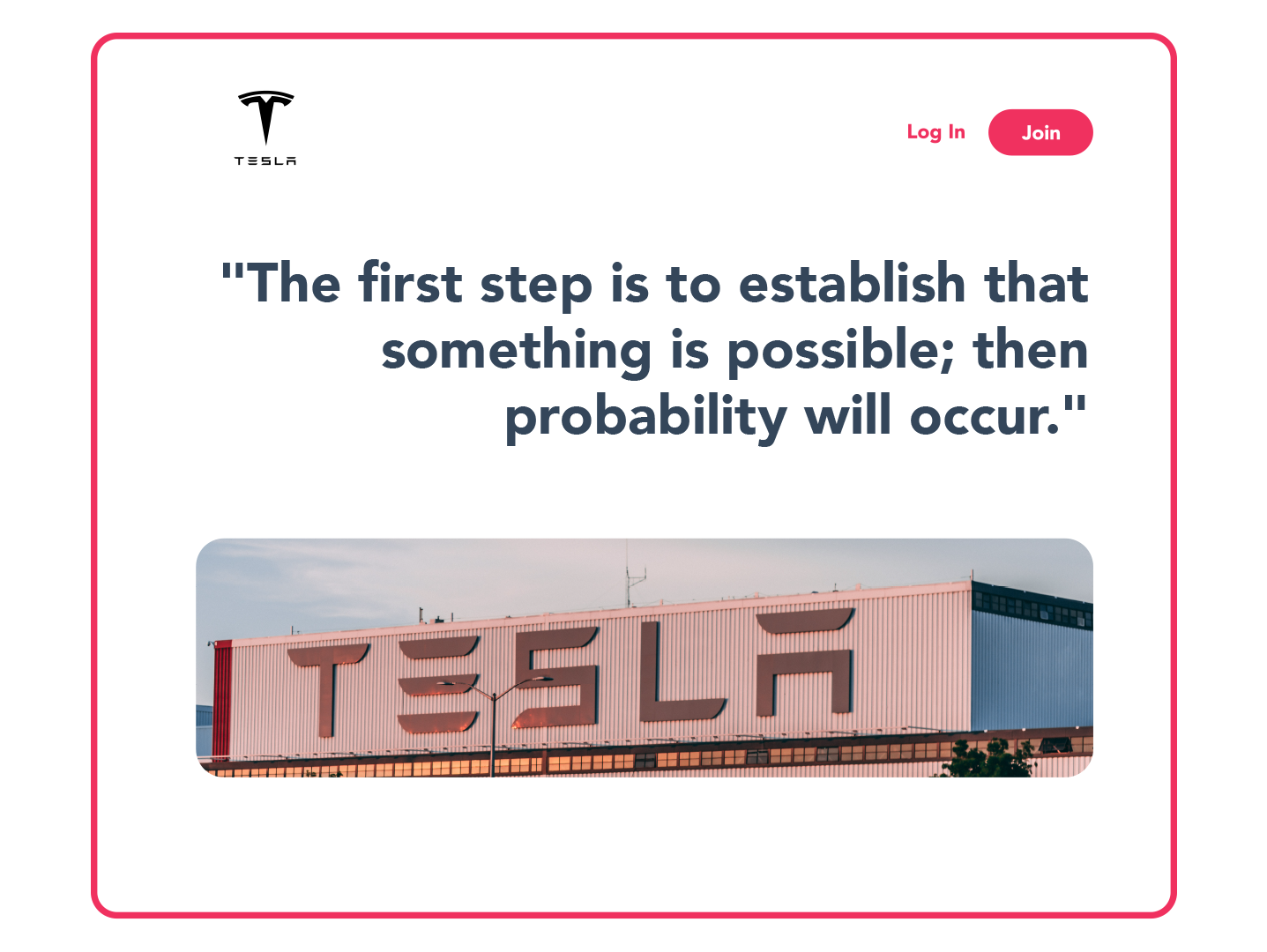
To kick-start the identification of your ideal audience, you will begin by manoeuvring through the first two stages: 1. Research and 2. Data (p.s. this is where most marketers rush and fall short!)
Both your research and your data will differ depending on whether you’re addressing your existing customer profiles - the long-term, loyal ones - or if you are branching out into new markets, with new prospects.
It’s important to begin by researching your own brand. Discover who you are; your goals, your vision, your mission. Only then can you envisage your ideal audience/s, and conduct meticulous market research. Remember that the primary aim of conducting market segmentation research is to get to know the needs and wants of your prospective audience and group them accordingly, into cosy little pods of shared characteristics.
So begin by asking these questions…
This will allow you to discover whether or not you’re on target.
Ray Jones, Adviser at Chartered Institute of Marketing (CIM)
Once you have identified your prospective, ideal audience, you can then get into the nitty-gritty; pinpointing real groups in the market through data collection and segment analysis.
Now, let’s get down to brass tacks. This part of your strategy will determine whether or not your chosen audience will want you in return.
This is where data comes in. Your segmentation data will let you know which of the markets exhibit the strongest affinity to your product, brand, service or content. Basically, market segmentation and data analysis make sure you’re not wasting your time.
As previously noted, we can define audiences by their demographic, geographic, psychographic and behavioural characteristics. You may simply choose a single method, e.g. demographic segmentation. However, some marketers find that using just one method of segmentation can leave their data a little short of any real, substantial detail. So you might combine two different segmentation types in order to yield more accurate and meaningful information. This could mean delving into the shared psychographic traits of your audience and using this data in tandem with demographic information such as their age or education.
Take these two hypothetical individuals:

Let’s assume that your brand sells music technology and appliances. Chances are, these two individuals will both love your brand but will choose completely separate products.
Here’s why:

She’s a high-earning traveller. She might purchase one of your pricey, waterproof, Bluetooth speakers because they’re ideal for listening to music beside a pool, on a beach or kayaking down a river.

Whilst User B, a cash-poor student, could choose your headphones which are noise-cancelling and are reasonably priced, so that he can study in peace, walk his dog - uninterrupted - and also not break the bank… p.s. he’ll be even more likely to purchase if you offer student discount!
These examples are clearly speculative, but they demonstrate how your customer segments can greatly differ, but at the same time, you can offer them both personalised, valuable products.
Market segmentation enables you to understand your audience: their emotional and factual differences and similarities. It also helps your brand to make more informed decisions that support your ambition to create hyper-personalised marketing content, products or services; motivating you to optimise that haphazard marketing campaign you’ve been mulling over.
So, you’ve set your objective and developed your segmentation strategy. What’s the last box to tick on your list of creating great segments? Your go-to-market strategy, of course!
Every brand wants to grow; to see success and thrive in a chosen market. But it’s not always that easy. Sure, your segmentation strategy is on-point, you have your goal, your objectives, and your vision. But you’re not done just yet. To reach the finish line and race through that red tape before your deadlines catch up with you, or your cutthroat competitors take over, you need to create and execute a solid go-to-market (GTM) strategy.
So what is it? Your GTM strategy is the bones, the blueprint, the step-by-step plan-of-action that you aim to take in order to bring together your defining features and move in a new direction.
It clarifies and specifies your purpose, as in the why behind your goals; who your product, service or content is for and how you’re going to connect with this ideal audience.
It essentially keeps your brand from slipping from Hero to Zero. And while it might sound a little daunting, it doesn’t have to be.
Here are our 5 key steps for creating and executing your GTM strategy:
1. Define your target markets
You can’t please all of the people all of the time, that’s just a fact of life. With this in mind, it’s important to first define your target market so that you’re clear on the challenges you will be addressing and to be confident that you’re offering the right thing to the right audience.
So don’t spread yourself too thin - in reality, there will be a select area of the market which your brand most suits, so ask yourself:
2. Define your target audience
Dig a little deeper: once you have defined your ideal market, characterise your ideal audience. Because the more you know about them, the more successful you will be. Consider:
3. Define your brand positioning
Your brand is unique. And your brand positioning is exactly what explains this to your audience, keeping you in a special place in their mind. A legitimate GTM strategy will always include a strong brand position. This is because your brand position is one of the main players when it comes to illustrating your competitive advantage and justifying your place in the chosen market. So start by addressing these fundamental questions:
4. Define your Unique Value Proposition (UVP)
Also known as a Unique Selling Point (USP), your UVP details the main features, benefits and attributes of what it is that you’re offering. Which, by extension, should also give context to your audience.
5. Select your Channels
This is undoubtedly one of the most important aspects of any GTM strategy. You may have successfully defined your product or brand position, but this work is all fruitless if you don’t have an audience to communicate with.
Your primary communication channels should be in line with your brand and your market segmentation data. For example, if your brand has both an online and high-street presence, you may want to utilise social media as well as traditional marketing methods, such as email, TV or even newspaper ads.
Your market segmentation will give you all the information that you need in order to proceed with your communication channels.
Nevertheless, reflection is always a good thing, so ask yourself:
Your GTM strategy should be hyper-focused, comprehensive and versatile - in that alterations can be made based on company and, crucially, audience feedback.
Steli Efti, CEO of Sales CRM at Close.com
Now that you have accurately made your journey through our 5 key steps, all you have left to do is monitor your GTM strategy, analyse the results and supervise any changes of your market segmentation.
When it comes down to it, your GTM strategy is more than just a concept. It’s a strategic document, a director, that helps to guide and support your brand through these pivotal moments. It details how, why and when you will utilise your resources to reach your audience and deliver unique value to them, thus gaining an overall competitive market advantage.
Related content: [Infographic] 7Ps of the Marketing Mix
Marketing today is all about communicating with your audience in the right way, in the right place, at the right time and with the right tools.
There are multiple factors that will affect the way you communicate with your audience. But worry-not, clever segmentation will detail the most appropriate, and effective, ways for you to do so.
We want our audience to interact with our brand. Because audiences that positively interact with brands offer something very valuable: positive Word Of Mouth [WOM]. And positive WOM means that you have created brand advocates, which essentially means free marketing for you. Hooray!
What do we have to consider?
The right way: voice
Talk to your audience in a personal way. Personalised communications emotionally compel your audience, which ensures and encourages continued brand loyalty.
Source: Cison
Are you a fun, energetic brand that screams ‘excitement’? Or perhaps your goal is to be seen as sophisticated and charming, and so your language is more professional and formal.
Whichever voice you choose to use, make sure it’s consistent with your brand personality. Unsure of what your brand personality is? Take a look at this framework:
Related content: 7 Types of Humour that will Transform Your Brand Voice
The right place: channel
You want to make sure that both your time and money are spent on the channels which will have the most effective impact on your audience. Luckily for us, selecting the right channels isn’t exactly rocket science.
Analysing your segmentation data will clarify the channels that are most appropriate for you and your audience to connect on.
The right time: push notifications & posting
Saying the wrong thing at the wrong time can ruin a great personal conversation. And the same goes for choosing the right time to communicate with your audience. For example, did you know that in Germany, people prefer to receive direct mail at the end of the week, or weekend, so that they have more time to digest the information? Whereas some audiences may see this as intrusive; being pestered at a time where they wish to disengage with work and relax.
Related content: 5 Ways to Avoid Becoming a Push Notification Pest
How do you discover these nuances? Well, you don’t have to. Your behavioural, geographic and psychographic segmentation analytics will demonstrate when your audience is most active, the cultural norms of the area, or the preferences of the user, and therefore the best time to trigger in-app messages or emails.
So know your audience: don’t overload your early birds with late-night notifications, no matter how good of a deal you’re offering, and don’t wake your night owls by sending push notifications before sunrise.
Get your timing right and ensure that no-one in your audience segments opts-out of your messages and flies away.
What is customer journey mapping?
Customer journey mapping, also known as the buyer's journey, is a visual representation of each experience that your customer has with you. It is essentially a tool that most brands use to monitor the growth and actions of their customers; to identify their goals, needs, experiences and pain points at each stage of their journey.
Mapping your customer’s journey means that you get to know them that little bit better. This allows you to create seamless experiences and, ultimately, ensures you don’t miss out on any chances to optimise those experiences that boost brand loyalty.
Where does segmentation fit in?
Your customers are yours because they are the segment of the market that you have chosen; that your analysis has correctly deemed the most appropriate for you, as per your criteria.
Customer journey mapping allows you to think about the actions and decisions you will make for the segments you have created, for both the long and short-term.
How? Because customer journey mapping uses demographic, geographic, psychographic and behavioural segmentation to analyse the actions of your consumers and the paths that they choose. With this data, you can make way for further segmentation and personalised or customisable experiences.
Segmentation is a marketer’s most trusted companion, and with good reason. Whether you’re choosing to market to a large audience or a niche one, make sure that your segments are the most appropriate size for your brand and it’s current and future goals.
Broad targeting
Focusing on large segments can have its up-sides, like being able to reach a varied number of prospects that have the potential to draw in more revenue. However, broad targeting can also be quite an expensive endeavour, and brands tend to lose out on profit simply by having to constantly test what works and what doesn’t, as the needs of their audiences are so varied.
Defining your segments broadly means that your business will miss out on the benefits of focused or niche marketing, unlike your competitors who are already doing it. Narrowly defined segments are the primary choice for a lot of brands as they allow for incredibly streamlined marketing and personalisation.
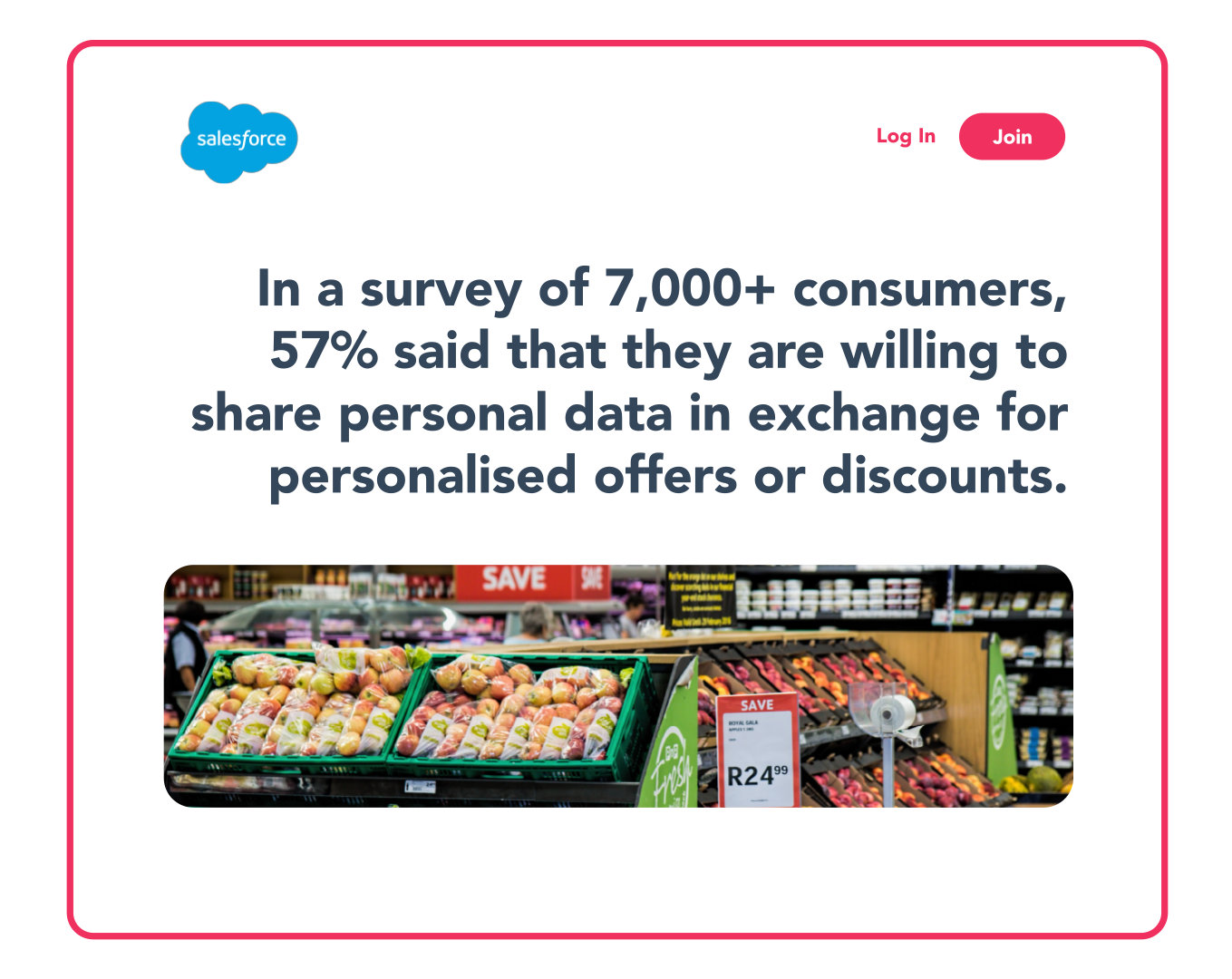
Source: Salesforce
As well as cutting costs, focused market segmentation makes you more likely to be rated as a thought leader, and has a greater potential to turn your audience into ardent brand advocates.
Strong branding is at the core of every successful business strategy for a number of reasons. Firstly, because it makes you recognisable, and therefore able to be differentiated from your competitors. Secondly, it’s your identity; it acts as the face of your business and is what your audience visualise when you’re communicating with them. If your brand differs depending on which location it’s operating in, it will lose recognition and, therefore, value.
Source: ClearVoice
Inconsistent branding can give you an air of ambiguity, which is essentially the opposite of strong branding. It also leaves you open to different, and potentially negative, interpretations. Brands that constantly change their personality or image can confuse audiences; every interaction you have with your audience should symbolise your brand values and core characteristics.
Consider these fundamental aspects when keeping your brand consistent across global (and local) markets:
Global branding can often be costly, but the opportunity to form and maintain positive relationships with your audience/s outweighs any potential problems or costs.
Essentially, people trust brands that they recognise and, to be recognisable, consistency is key.
Related reading: 6 Signs That You're Targeting The Wrong Market Segments
Just like the famous old proverb ‘the proof of the pudding (is in the eating)’, the proof of a successful marketing campaign is in the data. But data analysis is not simply reserved for campaign monitoring. We need analytics throughout the entire process: to evaluate and monitor our brand, our social presence, our progress and, particularly, to accurately segment our target audience.
Whether your brand is using Twitter, LinkedIn, Facebook, Instagram, YouTube or, well, the list goes on, you will have access to audience data.
Social media analytics is a great way to assess which aspects of your social media marketing are gaining traction, and which need improvement or further evaluation.
So what does social media actually track and what does this mean for you?
No matter what your answers to these questions are, you should always be thinking ‘what are the reasons for these metrics, and how can I optimise them?’
Along with behavioural insights, most social media sites also track demographic, geographic and psychographic data, which is one of the reasons why it’s such an integral tool for modern digital marketers and brands alike.
With over 3 billion daily active users on social media, that’s around 42% of the population, a figure that is ever-increasing, it’s vital that brands understand the importance and potential impact of a positive social media presence. Why? Because social platforms are where your audience resides; where they talk, interact, share feelings, experiences and review, well, everything.
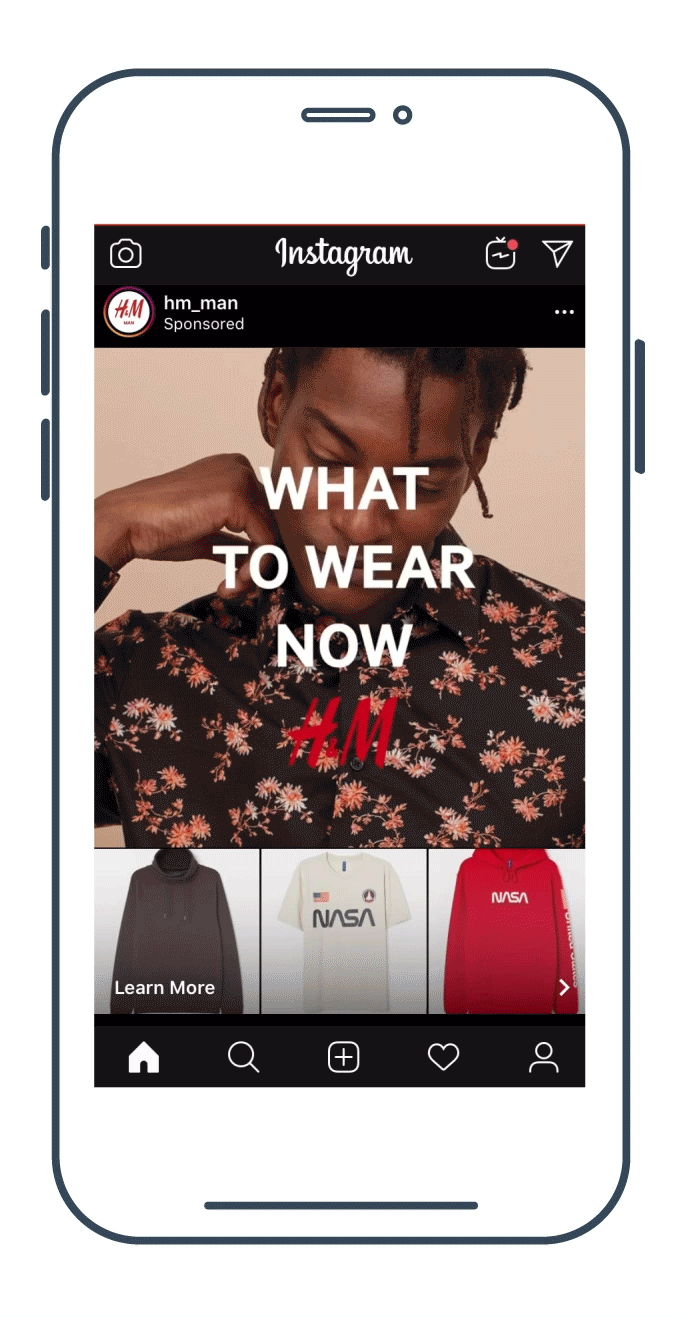
Source: Infosys
Social media is the gateway to getting personal and connecting with your audience. It’s one of the primary ways of increasing awareness through WOM, encouraging engagement, growing your name and communicating your authenticity.
Web analytics provide you with data about your website and those who visit it. When it comes to web analytics, there are a number of ways you can collect and analyse data. But for simplicity, we’re going to use Google Analytics as our example.
Web analytics deliver information that’s invaluable for brands. They're super important when it comes to measuring your KPIs, performance, conversion rates and insights which are key for future actions, problem-solving and optimisation.
In order for Google Analytics to track your website data, all you have to do is add a simple tracking code on your web pages.
So what can tools like Google Analytics actually track?
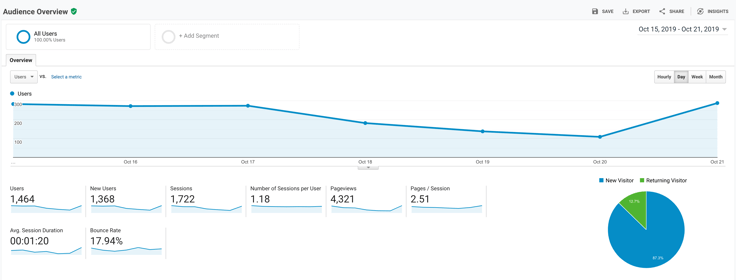
Example of audience overview: Google Merchandise Store - 3 Raw Data View
All of this data is collected and analysed in order to segment, or further segment, users and improve integral aspects of your brand such as user experience (UX), Search Engine Optimisation (SEO), Return On Investment (ROI), and ongoing development. Essentially, providing you with a roadmap to success.
Of course, your website, or the platform it lives on, may offer its own analytics data. When it comes down to it, the more data you can gather the better you will get to know your audience. So don’t hesitate to utilise as many tools as you can; using the analytics tools available to you, in tandem, can only benefit your brand.
1. Review
Regularly review your data to keep up-to-date with what’s working, what isn’t and if there are any changes in your audience's behaviour, characteristics or general information. Monitor which of your website pages are viewed most regularly, and which CTAs experience the most (and least) interaction. And it never hurts to audit your website, content and social media every so often.
2. Experiment
Conduct weekly marketing experiments with different aims each time. These aims could range from driving more traffic to your website, increasing followers on social media, improving ROI or driving leads. Weekly experiments will give you a consistent flow of data, which will ensure that you’re familiar with marketing trends and your own brand’s performance. And, you never know, the findings of one experiment could be the golden ticket that skyrockets you to success!
3. Act on your results.
There’s no point in gathering and analysing data just for it to sit there gathering dust. Your data offers you actionable insights with the aim of optimising your output and keeping your brand on the path to success. So don’t just collect data aimlessly; have focus; have a goal; act on your results and thrive.
Patrick Han, Analytics Associate at Seer Interactive
It’s no secret that the world of digital marketing is a volatile place. It’s laden with fresh theories, erratic trends, and ever-changing elements. But market segmentation is one practice whose impact on digital marketing has been consistently fruitful for brands, and it's really no surprise.
Clever market segmentation is the most efficient way to categorise, analyse and utilise audience information, creating segments that are valuable in both the long and short term.
Related content: Market Segmentation: Getting Started with our 5 Steps
The market population will always have an abundance of differences, similarities and common
characteristics. This means that if you really want to get to know your target audience and create optimised experiences and personalised offerings, then creating authentic segments is imperative.
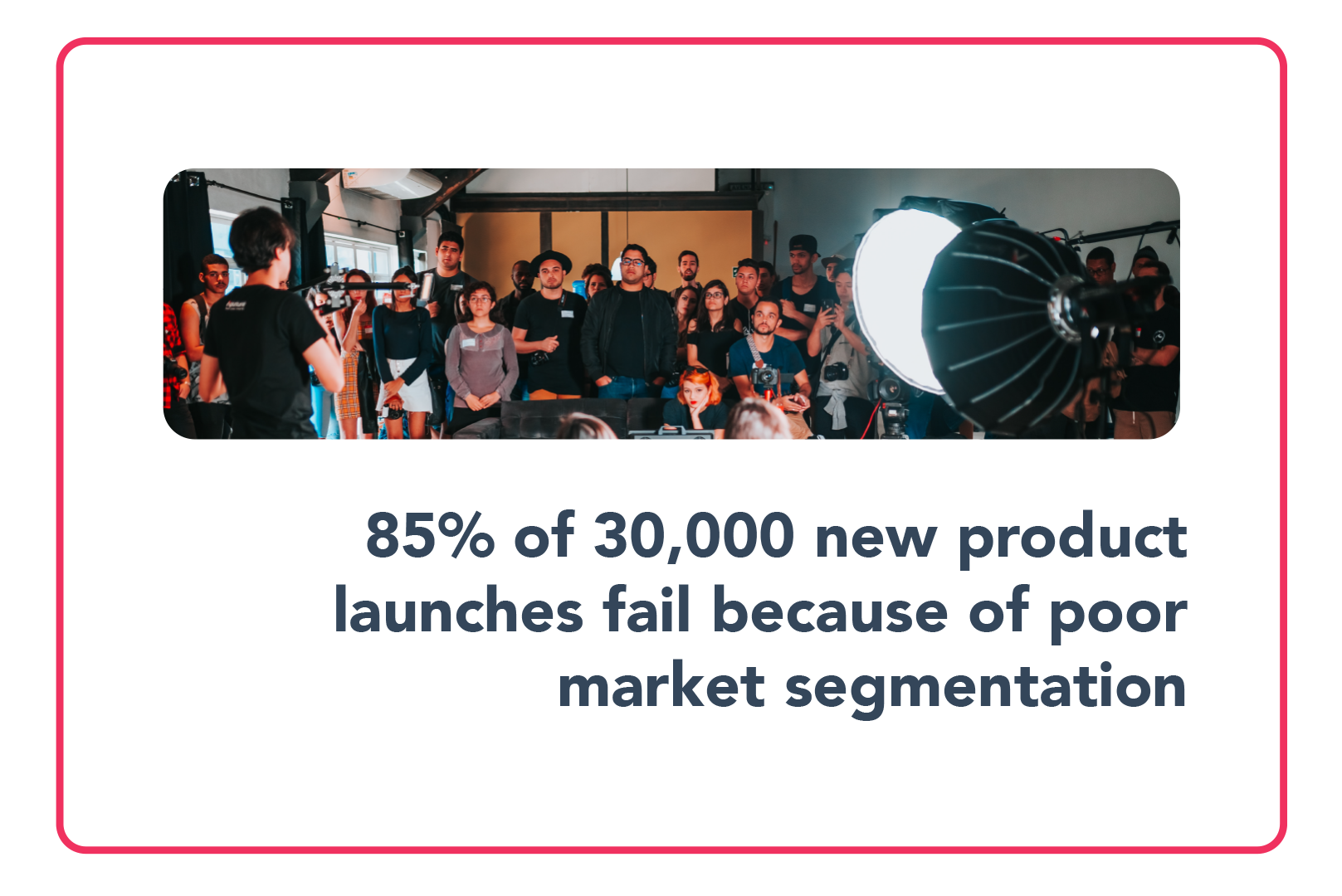
Source: Net Solutions
Developing an on-point segmentation strategy gives your brand focus and structure. Over the years, marketers have learned that with advancements like big data, innovative strategies, advanced analytics and dynamic segmentation, businesses can thrive.
Meticulous market segmentation paves the way in identifying those audiences who will deliver the most value for brands. And, in return, determines how brands can best serve and perfect the experiences of those audiences in order to act upon actionable insights and, ultimately, see real, unmistakable success.